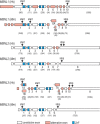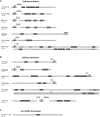MBNL proteins and their target RNAs, interaction and splicing regulation
- PMID: 25183524
- PMCID: PMC4176163
- DOI: 10.1093/nar/gku767
MBNL proteins and their target RNAs, interaction and splicing regulation
Abstract
Muscleblind-like (MBNL) proteins are key regulators of precursor and mature mRNA metabolism in mammals. Based on published and novel data, we explore models of tissue-specific MBNL interaction with RNA. We portray MBNL domains critical for RNA binding and splicing regulation, and the structure of MBNL's normal and pathogenic RNA targets, particularly in the context of myotonic dystrophy (DM), in which expanded CUG or CCUG repeat transcripts sequester several nuclear proteins including MBNLs. We also review the properties of MBNL/RNA complex, including recent data obtained from UV cross-linking and immunoprecipitation (CLIP-Seq), and discuss how this interaction shapes normal MBNL-dependent alternative splicing regulation. Finally, we review how this acquired knowledge about the pathogenic RNA structure and nature of MBNL sequestration can be translated into the design of therapeutic strategies against DM.
© The Author(s) 2014. Published by Oxford University Press on behalf of Nucleic Acids Research.
Figures






References
-
- Fardaei M., Rogers M., Thorpe H., Larkin K., Hamshere M., Harper P., Brook J. Three proteins, MBNL, MBLL and MBXL, co-localize in vivo with nuclear foci of expanded-repeat transcripts in DM1 and DM2 cells. Hum. Mol. Genet. 2002;11:805–814. - PubMed
-
- Kanadia R., Urbinati C., Crusselle V., Luo D., Lee Y.J., Harrison J., Oh S., Swanson M. Developmental expression of mouse muscleblind genes Mbnl1, Mbnl2 and Mbnl3. Gene Express. Patterns. 2003;3:459–462. - PubMed
-
- Squillace R., Chenault D., Wang E. Inhibition of muscle differentiation by the novel muscleblind-related protein CHCR. Dev. Biol. 2002;250:218–230. - PubMed
Publication types
MeSH terms
Substances
LinkOut - more resources
Full Text Sources
Other Literature Sources

